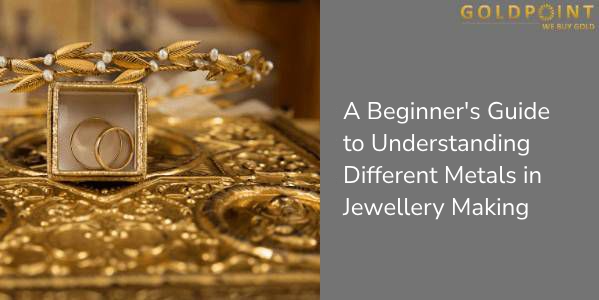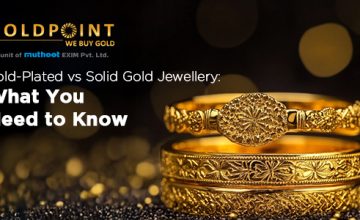
- জুন, 10 2023
- | Sell Gold
A Beginner’s Guide to Understanding Different Metals in Jewellery Making
In the captivating realm of jewellery, a wide variety of metals are employed in creating stunning pieces that are as remarkable and alluring as the precious gemstones they frequently display. With today’s fast-paced market and consumers consistently searching for cash for gold, it is crucial to grasp the unique attributes and uses of diverse metals within the jewellery-making process.
This guide aims to provide an engaging and informative overview of the most popular metals used in crafting beautiful and timeless jewellery pieces, ensuring you can make well-informed decisions as both a creator and a consumer.
Precious or Noble Metals
The usage of precious metals for jewelry dates back millennia. These metals are prized for their aesthetic value, scarcity, and longevity. Most jewellery is made of gold, silver, and platinum.
1. Gold
It is a highly sought-after metal in jewellery-making due to its unique properties, such as its malleability, ductility, and lustre. Gold is available in different karats, which determine its purity.
The most common carats used in jewellery-making are 18, 14, and 10 carats. 18-carat gold is the most pure, containing 75% gold and 25% other metals. 14-carat gold contains 58.3% gold, while 10-carat gold contains 41.7% gold.
Pros:
- Beautiful, lustrous appearance
- Resistant to tarnishing and corrosion
- Easy to work with due to its malleability
- It can be alloyed with other metals to create different colours and properties
Cons:
- Expensive, especially for higher carats
- Softness makes it prone to scratching and bending
- It can cause allergic reactions in some people
2. Silver
Another common best metals for jewelry is silver. It’s perfect for detailed patterns because of its dazzling white shine and malleability. Most jewellery is made from sterling silver, which is 92.5% silver and 7.5% other metals.
Pros:
- Bright white lustre
- Less expensive than gold
- Malleable and easy to work with
- Durable and resistant to tarnishing
Cons:
- Softness makes it prone to scratches and dents
- It can cause allergic reactions in some people
- Tarnishes easily and requires regular polishing
3. Platinum
Platinum is among the most costly precious metals ever utilised for jewellery production. It is dense, brilliant white, and durable. Platinum is hypoallergenic, making it a good choice for delicate skin.
Pros:
- Extremely durable and resistant to scratches and wear
- Hypoallergenic and suitable for those with sensitive skin
- Beautiful white lustre
- Resistant to tarnishing and corrosion
Cons:
- Expensive, making it less accessible to many people
- Heavier than other metals, which can be uncomfortable to wear for some people
- It can be difficult to work with due to its density and hardness
Consider price, design, and durability when choosing a precious metal for jewellery-making. Understanding the qualities of each precious metal helps you pick the ideal one for your project.
Non-Precious or Base Metals
Even though precious metals are more expensive and sought after for jewellery-making, non-precious metals may be just as appealing and have unique properties that make them suitable choices for certain types of jewellery.
The jewellery industry’s most popular precious metal substitutes are mentioned below.
- Copper: Copper is reddish-brown and soft. Jewellery makers use it because of its affordability and unusual appearance. Copper is suitable for complex designs and patterns due to its malleability. It can be plated with silver or gold to improve its beauty and longevity.
- Brass: Brass is a copper-zinc alloy with different hues depending on the ratio. Due to its durability and affordability, brass makes exceptional jewellery. It is easy to texture and engrave. Brass can be plated with gold or silver to prevent tarnishing and improve its look.
- Stainless steel: Jewellery is often made of stainless steel, a durable and cheap metal. For long-lasting jewellery, it resists tarnishing, scratching, and corrosion. Stainless steel is very easy to shape and polish. It’s great for sensitive skin because it’s hypoallergenic. However, it is less malleable than other metals, making it challenging to work with for some jewellery.
Other Metals – Titanium, Palladium and Tungsten
Titanium, palladium, and tungsten are becoming more popular in jewellery due to their unique qualities and beauty. Titanium, a famous men’s wedding ring material, is lightweight and robust.
Palladium is cheaper than platinum yet looks and lasts the same. Tungsten may be used to make elaborate patterns and is scratch-resistant. These metals are not as prevalent as gold or silver, yet they are utilised in jewellery production.
Conclusion
Making informed decisions that cater to design preferences, budget, and durability requirements, ultimately ensures the beauty and longevity of jewellery are adequately maintained in the long run. In order to make the right decisions, gold buyers online need to be aware of the diverse range of metals in jewellery-making, from precious options like gold, silver, and platinum to non-precious and emerging alternatives.










